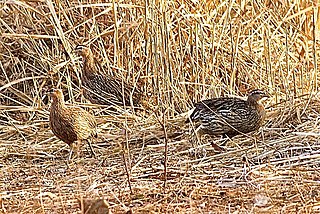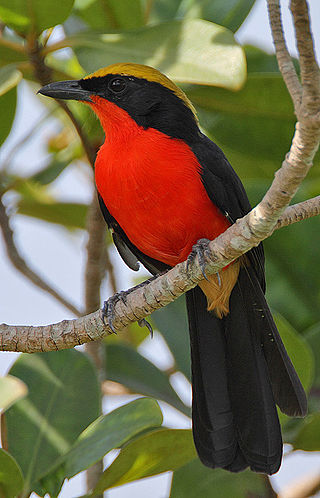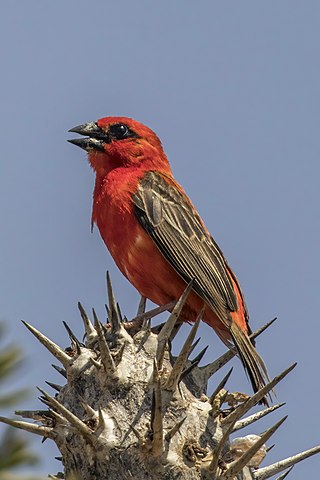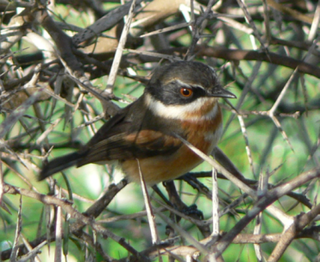
The mosque swallow is a large species of swallow. It is a resident breeder in much of sub-Saharan Africa, although most common in the west. It does not migrate but follows the rains to some extent.

The double-spurred spurfowl is a gamebird in the pheasant family Phasianidae of the order Galliformes, gallinaceous birds. Like most spurfowls, it is restricted to Africa. It is a resident breeder in tropical west Africa, but there is a small and declining isolated population in Morocco.

The black-crowned tchagra is a bushshrike. This family of passerine birds is closely related to the true shrikes in the family Laniidae, and was once included in that group.

The garden sunbird, previously known as the olive-backed sunbird, is a species of passerine bird in the family Nectariniidae that is found in the Philippines except on the Palawan island group. It was formerly considered to be conspecific with seven other species: the ornate sunbird, Palawan sunbird, Sahul sunbird, Tukangbesi sunbird, Flores Sea sunbird, South Moluccan sunbird and the Mamberamo sunbird. It is a small, brightly coloured bird with olive-green plumage on the wings and back with a bright yellow chest. It has a long downward-curved bill it uses for taking nectar and capturing insects. It is primarily nectarivorous, but will take insects and spiders, particularly when feeding chicks.

The Senegal coucal is a member of the cuckoo order of birds, the Cuculiformes, which also includes the roadrunners, the anis, and the hoatzin. It is a medium-sized member of its genus and is found in lightly-wooded country and savannah in central and southern Africa.

The African grey hornbill is a member of the hornbill family of mainly tropical near-passerine birds found in the Old World. It is a widespread resident breeder in much of sub-Saharan Africa and the southwest of the Arabian Peninsula. The African grey hornbill has escaped or been deliberately released into Florida, USA, but there is no evidence that the population is breeding and may only persist due to continuing releases or escapes.

The Senegal parrot is a parrot which is a resident breeder across a wide range of west Africa. It makes migrations within west Africa, according to the availability of the fruit, seeds and blossoms which make up its diet. It is considered a farm pest in Africa, often feeding on maize or millet. It is popular in aviculture.

The laughing dove is a small pigeon that is a resident breeder in Africa, the Middle East, South Asia, and Western Australia where it has established itself in the wild after being released from Perth Zoo in 1898. This small long-tailed dove is found in dry scrub and semi-desert habitats where pairs can often be seen feeding on the ground. It is closely related to the spotted dove which is distinguished by a white and black chequered necklace. Other names include laughing turtle dove, palm dove and Senegal dove while in Asia the name little brown dove is often used.

The yellow-billed oxpecker is a passerine bird in the family Buphagidae. It was previously placed in the starling and myna family, Sturnidae.

The yellow-crowned gonolek, also known as the common gonolek, is a medium-sized passerine bird in the bushshrike family. It is a common resident breeding bird in equatorial Africa from Senegal and Democratic Republic of Congo east to Ethiopia. It is a skulking bird and frequents dense undergrowth in forests and other wooded habitats. The nest is a cup structure in a bush or tree in which two eggs are laid.

The red-billed firefinch or Senegal firefinch is a small seed-eating bird in the family Estrildidae. This is a resident breeding bird in most of Sub-Saharan Africa with an estimated global extent of occurrence of 10,000,000 km2. It was introduced to Egypt, but the population there has become extinct. It was also introduced to southern Algeria where it is currently expanding northward.

The orange-breasted sunbird is a species of small, predominantly nectar-feeding bird that is endemic to the fynbos shrubland biome of southwestern South Africa. It is the only member of the genus Anthobaphes, in the family Nectariniidae, though it is sometimes placed in the genus Nectarinia. The birds are sexually dimorphic, with females being olive green while the males are orange to yellow on the underside with bright green, blue and purple on the head and neck.

The yellow bishop, also known as Cape bishop, Cape widow or yellow-rumped widow, is a resident breeding bird species in Angola, Botswana, Burundi, Cameroon, Congo, Equatorial Guinea, Eswatini, Ethiopia, Kenya, Lesotho, Malawi, Mozambique, Nigeria, Rwanda, South Africa, South Sudan, Tanzania, Uganda, Zambia and Zimbabwe.

The red fody, also known as the Madagascar fody in Madagascar, red cardinal fody in Mauritius, or common fody, is a small bird native to Madagascar and introduced to various other islands in the Indian Ocean. It is a common bird within its restricted range, and the International Union for Conservation of Nature has assessed its conservation status as being of "least concern".

The Cape batis is a small, stout insect-eating passerine bird in the wattle-eye family. It is endemic to the Afromontane forests of southern Africa.

The yellow-green grosbeak is a species of grosbeak in the family Cardinalidae.

The blue-spotted wood dove or blue-spotted dove is a species of bird in the family Columbidae. It is abundantly present throughout Africa south of the Sahel; it is partially present in East Africa and absent in southern Africa.

The Senegal batis is a species of small passerine bird in the wattle-eyes family, Platysteiridae. It occurs in western Africa where it is found in dry savanna and subtropical or tropical dry shrubland. It was originally given the binomial name Muscicapa senegalensis by Carl Linnaeus in 1766.

The purple-throated sunbird, is a species of bird in the family Nectariniidae. Its natural habitats are lowland tropical forests and subtropical or tropical mangrove forests of Maratua and the Philippines.

The Réunion olive white-eye is a species of bird in the family Zosteropidae. It is found on Réunion. Its natural habitats are boreal forests and subtropical or tropical high-altitude grassland.




























